The Wrack
The Wrack is the Wells Reserve blog, our collective logbook on the web.
The Wrack is the Wells Reserve blog, our collective logbook on the web.
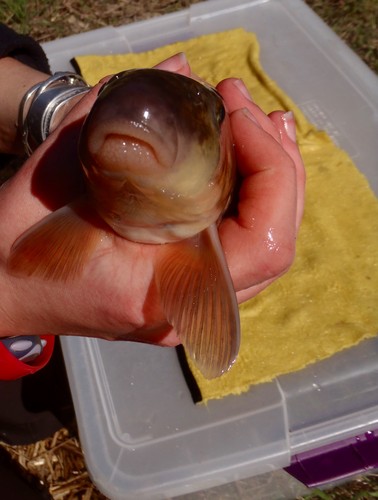 For the past five weeks, our research staff have been out fishing in the rivers of southern Maine to provide up-to-date information on species with the greatest need for conservation. We have been fortunate to have the help of some dedicated community volunteers and members of the Sebago Chapter of Trout Unlimited. This is the earliest we’ve been fishing in recent years and the catch has been diverse and exciting!
For the past five weeks, our research staff have been out fishing in the rivers of southern Maine to provide up-to-date information on species with the greatest need for conservation. We have been fortunate to have the help of some dedicated community volunteers and members of the Sebago Chapter of Trout Unlimited. This is the earliest we’ve been fishing in recent years and the catch has been diverse and exciting!
The Maine Department of Marine Resources (DMR) has identified potential spawning habitat for fish species such as rainbow smelt (a federally listed species of concern) and alewife throughout coastal Maine. These locations are places where the habitat looks like it would support reproduction by these species but there is no available data on whether or not there is an active population. The Wells Reserve is partnering with DMR, the Maine Coastal Program, and The Nature Conservancy to document the presence of rainbow smelt and alewives in several coastal rivers in southern Maine to help fill in these information gaps. Our sampling targets six rivers in York County, including (from south to north: the Salmon Falls River, Merriland River, Little River, Mousam River, Kennebunk River, and the Little River in Biddeford.
Rainbow smelt live most of their life in salt water and migrate to fresh water to spawn. They once supported a large commercial and recreational fishing industry along much of the eastern United States. However, there has been a drastic decline in population numbers and the range of this species since the late 1800’s. Today, Buzzards Bay, just south of Cape Cod, is the southern range limit of spawning rainbow smelt. Other places in Massachusetts, New Hampshire, Maine, and Canada still have strong springtime spawning runs but nothing compared to the historical records.
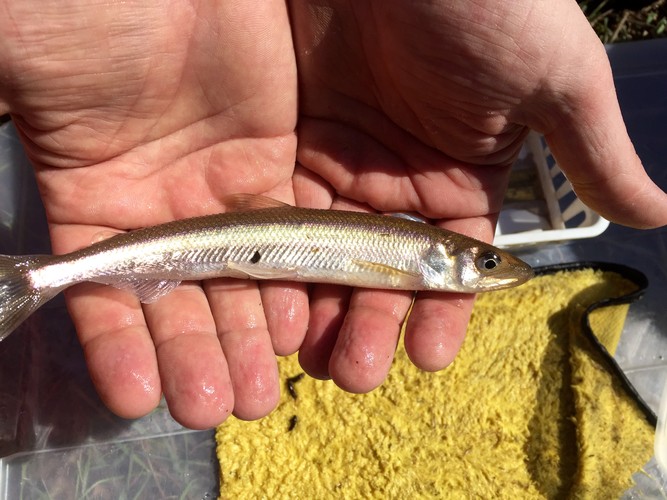
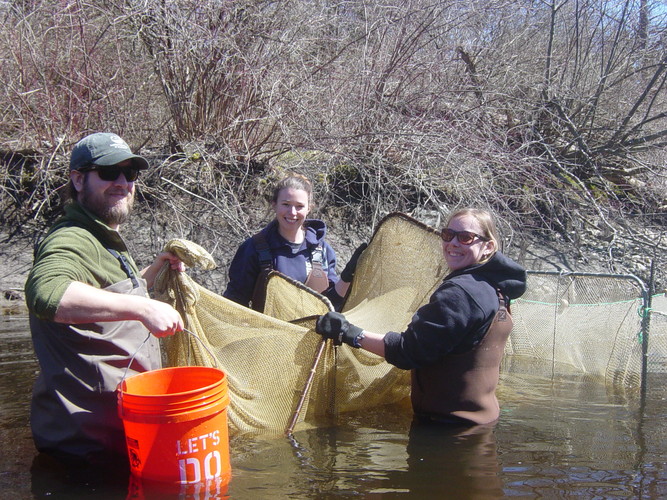
The exact reasons for the decrease in abundance and range are unknown, but scientists suspect habitat loss, habitat impairment, and changes to the quality of spawning habitat such as water quality. Smelt are weak swimmers and are unable to make it through undersized culverts, or over even small natural falls. They are also unable to use fish ladders to pass dams. Spawning habitat for rainbow smelt is characterized by rivers and streams swift moving water over cobble and gravel above the influence of tide water, where no salinity will reach their eggs. Spawning habitat can be degraded by building of dams and road crossings, and cutting of trees in along the stream bank which encourages algae by letting in more sunlight.
In addition to rainbow smelt we are interested in sampling several other diadromous species. Diadromous species are fish that use both saltwater and freshwater habitats to complete their life cycle. As they migrate upstream we trap these fish using fyke nets. A fyke net is a trap made of a soft mesh netting strung from several frames with a series of funnel openings allow fish to enter but make it difficult for them to get out. Fyke nets are relatively easy to work with and can be set in a variety of habitats, including shallow waters where they are easily accessible yet water is always passing through so survival of catch is typically quite high.
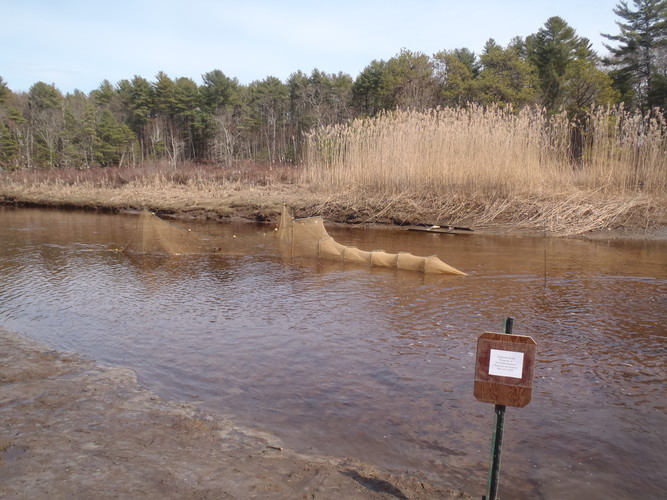 So far our catch has included numerous small saltwater and freshwater species such as sticklebacks, shiners, mummichogs, killifish, and sunfish. These species are typical estuarine and freshwater residents and are important food for many species that inhabit our coastal rivers. We are also very excited to have found several diadromous fish species in our nets. By the end of April, we have seen rainbow smelt, sea lamprey, alewife, sea run brook trout, Atlantic tomcod, and American eel.
So far our catch has included numerous small saltwater and freshwater species such as sticklebacks, shiners, mummichogs, killifish, and sunfish. These species are typical estuarine and freshwater residents and are important food for many species that inhabit our coastal rivers. We are also very excited to have found several diadromous fish species in our nets. By the end of April, we have seen rainbow smelt, sea lamprey, alewife, sea run brook trout, Atlantic tomcod, and American eel.
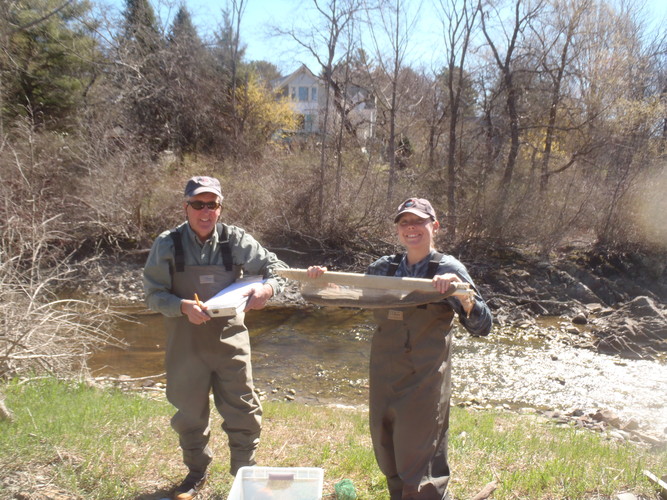 Research Assistant Brenda and Volunteer, Jay, measuring a sea lamprey.
Research Assistant Brenda and Volunteer, Jay, measuring a sea lamprey.
In recent years we have monitored these same diadromous fish in the Branch Brook estuary and at the fish ladder at the Kennebunk/Kennebunkport/Wells Water District. It is really interesting to continue to find these species in small numbers in nearby coastal streams, and it's a good sign that they are still hanging around despite loss of habitat. The presence of these remnant populations of diadromous fish provides the potential for recovery of these species if habitat conditions can be improved through conservation actions by communities and fisheries agencies.
Our sampling will continue into the summer to coincide with the timing of migrations of alewife, blueback herring, American shad and sea lamprey. In addition to monitoring spawning adults we also hope to sample juvenile fish that hatched this spring, as they make their way into our estuaries to grow and eventually return to the sea. Stay tuned for updates on what we are seeing in the river!
This project was funded in part by the Maine Outdoor Heritage Fund, in which proceeds from the sale of a dedicated instant lottery ticket, currently "Maine-AH Money", are used to support outdoor recreation and natural resource conservation. For more information about MOHF, go to www.maine.gov/ifw/MOHF.html.
Information for this article regarding rainbow smelt was collected from A Regional Conservation Plan for Anadromous Rainbow Smelt in the U.S. Gulf of Maine, put together by Maine Department of Marine Resources, Massachusetts Division of Marine Fisheries, New Hampshire Fish and Game Department, and University of Maine. This plan can be viewed online here: http://www.wildlife.state.nh.us/marine/documents/smelt-conservation-plan.pdf
Stream habitat for coastal Maine can be viewed online through the Maine Stream Habitat Viewer. http://mapserver.maine.gov/streamviewer/index.html
